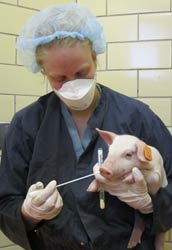New research details spread of swine flu virus
July / August 2011 | Volume 10, Issue 4

Photo courtesy of Susan Detmer
The spread of the A/H1 virus
follows movements of swine from
the South to the Midwest.
The spread of the influenza A/H1 virus follows large-scale movements of swine from the South to the Midwest, according to a new paper by Fogarty investigators published in PLoS Pathogens. Thus, farmers should not only conduct their own localized surveillance, but information must be amassed and shared at national and regional levels to inform vaccine design and targeted surveillance strategies.
This study suggests that even though the Midwest traditionally has the largest swine populations in the U.S., influenza surveillance efforts should be concentrated in the South, where new influenza viruses originate. Based on these findings, what should swine farmers do differently?
"I believe the salient point here for farmers is that influenza viruses are continuously emerging in swine and disseminating along key U.S. 'swine-ways' from the southern to the Midwest region," said Dr. Martha I. Nelson, a Fogarty postdoctoral fellow who led the study. "Hence, viruses that emerge in states such as North Carolina or Oklahoma quickly disseminate to Iowa, Minnesota, and other major pig-producing states."
Nelson added that this study is important for human health as there are frequent introductions of swine influenza viruses into human populations, and vice versa, as illustrated by the 2009 pandemic virus.
Since 1998, genetically and antigenically diverse influenza A viruses have circulated in North American swine due to continuous cross-species transmission and reassortment with avian and human influenza viruses, presenting a pandemic threat to humans. Millions of swine are transported year-round from the southern U.S. into the corn-rich Midwest, but the importance of these movements in the spatial dissemination and evolution of the influenza virus in swine is unknown. Using a large data set of influenza virus sequences collected in North American swine during 2003-2010, researchers investigated the spatial dynamics of two influenza viruses of the H1 subtype that were introduced into swine from humans around 2003.
Employing recently developed Bayesian phylogeography methods - a way of mapping the geographic distribution of viruses - they found that the spread of this influenza virus follows the large-scale transport of swine from the South to the Midwest. Based on this pattern of viral migration, they suggest that the genetic diversity of swine influenza viruses in the Midwest is continually augmented by the importation of viruses from source populations located in the South.
Understanding the importance of long-distance pig movements in the evolution and spatial dissemination of influenza virus in swine may inform future strategies for the surveillance and control of influenza, and perhaps other swine pathogens.
Fogarty senior scientist Dr. Cecile Viboud, one of the co-authors of the paper, entitled "Spatial Dynamics of Human-Origin H1 Influenza A Virus in North American Swine," said that their findings should encourage "intensified surveillance" in the southern states to curtail the spread of the influenza virus.
In addition to the Fogarty researchers, other collaborators included evolutionary biologists at Pennsylvania State University, the University of California at Los Angeles, Edinburgh University and veterinarians at the University of Minnesota.
The study’s importance was enhanced by a recent WHO report that a novel variant of swine flu has emerged in Asia with a genetic variant showing some resistance to the two mainstay drugs used to counter the disease.
More than 10 percent of the H1N1 infections in Singapore and 30 percent of those in northern Australia tested in early 2011 had reduced sensitivity to the two drugs. The H1N1 pandemic caused about 18,450 deaths worldwide from March 2009 through August 2010, according to WHO.
More Information
To view Adobe PDF files,
download current, free accessible plug-ins from Adobe's website.